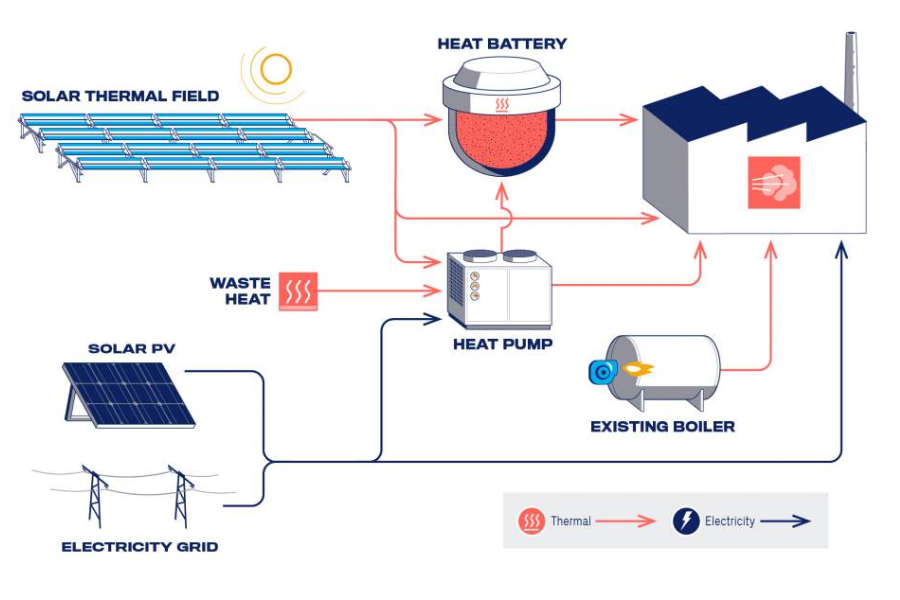INTRODUCTION:
The lifecycle of renewable heating technologies is a crucial aspect to consider when evaluating their long-term benefits and sustainability. As the world increasingly turns to alternative energy sources, understanding these technologies’ development, installation, and operational phases can offer valuable insights into their overall impact. Renewable heating systems, such as solar thermal, heat pumps, and biomass boilers, promise to reduce dependency on fossil fuels and cut greenhouse gas emissions, but their effectiveness is closely tied to their lifecycle stages. Examining these stages helps in assessing not only the immediate benefits but also the long-term viability and efficiency of these systems.
In-depth analysis of renewable heating technologies reveals a range of factors influencing their performance and sustainability. This includes the selection of materials, energy input required for production, installation processes, operational efficiency, and end-of-life considerations. By exploring each phase of the lifecycle, a clearer picture of how these technologies fit into broader energy strategies and their potential role in achieving environmental goals can be formed. This comprehensive understanding aids in making informed decisions about adopting and promoting renewable heating solutions.
TECHNOLOGY SELECTION AND DEVELOPMENT:
“The selection and development of renewable heating technologies involve multiple stages that significantly affect their overall performance. During the initial phase, considerations such as energy efficiency, cost-effectiveness, and compatibility with existing systems are paramount. Technologies like solar thermal systems rely on the effective capture and conversion of sunlight into heat, which necessitates the use of high-quality materials and advanced engineering. Heat pumps, on the other hand, focus on transferring heat from the environment into buildings, requiring detailed analysis of heat sources and energy consumption patterns. The choice of technology and its development process are critical in determining the effectiveness and efficiency of the final product.
Development also encompasses research and innovation aimed at improving existing technologies and creating new ones. Advances in materials science and engineering contribute to enhancing the performance of renewable heating systems. For instance, improvements in solar panel efficiency and heat pump technology have led to better energy conversion and reduced operational costs. This ongoing innovation ensures that renewable heating solutions remain competitive and can meet the evolving needs of consumers and the environment.” – Jessica Shee from iboysoft.com
INSTALLATION PROCESSES AND CHALLENGES:
The installation of renewable heating technologies represents a vital phase in their lifecycle, impacting their efficiency and effectiveness. Proper installation ensures that systems operate at their optimal capacity, delivering the expected energy savings and environmental benefits. The process involves site assessments, system design, and the actual installation of components. For solar thermal systems, the positioning of panels and integration with existing infrastructure are crucial for maximizing sunlight capture. Heat pumps require careful placement to ensure efficient heat transfer, while biomass boilers need appropriate space for fuel storage and maintenance access.
Challenges during installation can affect the overall performance and longevity of renewable heating systems. Issues such as incorrect sizing, poor installation practices, or inadequate integration with existing systems can lead to reduced efficiency and increased operational costs. Addressing these challenges through proper planning, professional installation, and regular maintenance is essential for ensuring that renewable heating technologies deliver their intended benefits over their lifespan.
OPERATIONAL EFFICIENCY AND MAINTENANCE:
Operational efficiency is a key factor in determining the success of renewable heating technologies. Once installed, these systems must operate effectively to provide the anticipated energy savings and environmental benefits. For solar thermal systems, factors such as sunlight availability, system orientation, and weather conditions can influence efficiency. Heat pumps depend on factors like ambient temperature and system settings to achieve optimal performance. Biomass boilers require consistent fuel quality and proper combustion conditions to operate efficiently.
Regular maintenance is essential for sustaining operational efficiency and prolonging the lifespan of renewable heating technologies. Routine checks, cleaning, and servicing help to prevent performance issues and identify potential problems before they escalate. For example, solar panels should be inspected for dirt and debris that may obstruct sunlight, while heat pumps need periodic checks to ensure refrigerant levels and system components are functioning correctly. Effective maintenance practices contribute to the long-term reliability and cost-effectiveness of renewable heating systems.
INTEGRATING RENEWABLE HEATING TECHNOLOGIES WITH ENERGY EFFICIENCY STRATEGIES:
“The integration of renewable heating technologies with broader energy efficiency strategies is essential for maximizing overall performance and environmental benefits. By combining renewable heating systems with energy-efficient practices and technologies, a more holistic approach to energy management can be achieved. This integration ensures that buildings not only benefit from renewable energy sources but also make the most of improved insulation, energy-saving appliances, and smart control systems. The synergy between these elements enhances the overall effectiveness of energy solutions, leading to greater cost savings and reduced environmental impact.
Energy efficiency strategies, such as optimizing building design and implementing advanced control systems, complement renewable heating technologies by addressing various aspects of energy consumption. For example, improving insulation and reducing heat loss can enhance the performance of solar thermal systems and heat pumps. Similarly, integrating renewable heating with smart home technologies can provide better control over energy usage, further contributing to energy savings. This comprehensive approach supports a more sustainable and efficient energy future, aligning with broader goals of reducing energy consumption and lowering carbon emissions.” – Marley Hayles, Digital Marketing Manager at HomeTree
END-OF-LIFE CONSIDERATIONS AND RECYCLING:
End-of-life considerations play a significant role in the overall sustainability of renewable heating technologies. As systems reach the end of their operational life, their disposal and recycling become important factors to address. Proper end-of-life management ensures that materials are recycled or disposed of responsibly, minimizing environmental impact. For instance, components such as solar panels and heat pump parts can often be recycled or repurposed, reducing the need for new raw materials and lessening the ecological footprint of the technology.
Recycling and disposal practices are governed by regulations and industry standards that aim to promote environmental responsibility. The implementation of effective recycling programs and adherence to best practices can enhance the sustainability of renewable heating technologies. Additionally, ongoing research into recycling methods and material recovery helps to improve the overall lifecycle impact of these systems, contributing to a more sustainable future.
CONCLUSION:
The lifecycle of renewable heating technologies encompasses a range of stages that collectively determine their effectiveness and sustainability. From the initial selection and development through installation, operation, and end-of-life considerations, each phase plays a crucial role in shaping the overall performance and environmental impact of these systems. Understanding these stages helps to make informed decisions about adopting and utilizing renewable heating solutions, ensuring that they meet both immediate and long-term energy and environmental goals.
Continued advancements in technology and practices are essential for optimizing the lifecycle of renewable heating systems. As innovations in materials, installation techniques, and maintenance practices emerge, the effectiveness and sustainability of these technologies will likely improve. Embracing a comprehensive approach to managing the lifecycle of renewable heating technologies supports the transition towards a more sustainable and energy-efficient future.
Keep an eye for more news & updates on DiscoverTribune!




